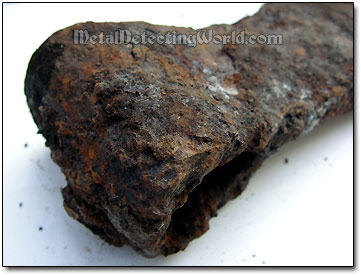Rust Removal by Electrolysis - A Detailed Illustrated Tutorial, page 2
1. Introduction to Electrolysis Rust Removal:
What is Rust? What is Electrolysis? What Causes Pitting?
1) What is Rust?
When an iron object is exposed to the air with some humidity, it undergoes a process known as Rusting - an electrochemical process. There are two types of rust.
1) The visible "outer-layer rust" is a powdery or scaly reddish-brown or reddish-yellow substance called Hydrated Ferric Oxide, or Hydrated Iron (III) Oxide, with a chemical formula Fe2O3 (nH2O). During the process of rusting, the outer-layer rust undergoes a large increase in its volume; as a result, the rust cracks and flakes off, thus causing irreversible loss of the surface metal over time. In the adverse outdoor conditions, the damage might be substantial: the outer-layer rust can completely disintegrate an iron object. As the red rust is a poor conductor of electricity, it prevents electrical contact between the corroded iron parts.
Heavy Outer-Layer Rust on Axe Head's Poll

2) The second type of rust, called "Black Rust", may be found underneath the outer-layer rust. "Black Rust" has a dark purple color when freshly exposed, a chemical formula Fe3O4 - the same chemical composition as the mineral Magnetite. Because the black rust is often in direct contact with the metal's surface and strongly bonded to it, it does not become detached and flake off. Unlike the outer-layer red rust, the black rust does not undergo any increase in its volume; thus, causing only minimal damage to the surface features. And the black rust conducts electricity.
2) What is Electrolysis? (a little of Chemistry here)
In simple words: Electrolysis is the separation of atoms by using electricity.
In electrochemical terms: Electrolysis is a decomposition of chemical compounds by means of passing a direct electric current (DC) through an electrolyte (a solution of acid, base or salt).
In electrolysis, electric energy comes from an external DC power supply and induces the migration of electrolyte's ions (atoms that have acquired a net electric charge by gaining or losing electrons) to the electrodes: positive ions (cations) to the negative electrode (cathode) and negative ions (anions) to the positive electrode (anode). The ions react with the electrodes, either receiving (reduction reaction) or giving up (oxidation reaction) electrons. In electrolysis rust removal, some resultant atoms are liberated as a gas (hydrogen, oxygen), and other resultant atoms are deposited as a solid on the electrodes (black sodium carbonate, rust).
Because the natural process of rusting is an electrochemical spontaneous reaction, during the electrolytic derusting, this reaction is put in reverse. Of course, fresh iron metal does not appear at the rusty spots, but the rust is not only electrochemically transferred from an artifact onto an anode (it is like the anode gets electroplated with the artifact's rust), but also is mechanically removed off the artifact by the evolved hydrogen. In the electrolytical removal of corrosion from any non-ferrous object, only the latter takes place. However, the water is split into gaseous hydrogen and oxygen in all cases.
During the electrolytic derusting, two processes are happening simultaneously: 1) much of the red rust is converted to Fe3O4 and becomes detached from the iron object's surface, 2) the remaining rust is converted into an easily removed deposit. In addition, chlorides (they enhance rusting) and other anions are drawn from the iron surface and migrate toward the positively charged anode by electrolytic attraction. In other words, moisture as well as salts are driven from the artifact's inside. Thus, electrolysis provides a cleaner (and, therefore, susceptible to future rusting) iron surface for you to seal during the conservation and preservation procedures.
Electrolysis was discovered by English scientists William Nicholson and Sir Anthony Carlisle, and independently by a German chemist Johann Ritter - they all decomposed water into hydrogen and oxygen, in 1800. Today electrolysis is used for many purposes, including the production of chlorine, hydrogen, and sodium hydroxide (caustic soda), the extraction of metals from ores (aluminum, copper, zinc and lead is produced industrially in electrolytic cells), the coating of materials with thin layers of metal (electroplating), the implementation of a number of electrochemical analytical techniques, such as polarography (the study of solutions or of electrode processes), and, of course, the cleaning of archaeological artifacts. In Cosmetology, electrolysis is used for destruction of hair roots by means of an electric current applied with a needle-shaped electrode; the process is also called Depilation
Does Electrolysis Cause Pitting?
No! After performing electrolysis on the partially rusted iron objects, and later checking their surfaces with a magnifying glass, I saw only damage caused by prior rusting. These derusted objects showed no pitting, in contrast to the formerly badly rusted artifacts which showed significant pitting where the rust had removed iron bit by bit over time. My conclusion was that the pitting on a freshly derusted artifact had already existed before derusting.
So, if you see any superficial damage - pitting, scarring, or cracking, on your artifact after electrolytic cleaning, it cannot be the damage caused by electrolysis. It is the damage simply revealed after the rust has been removed. An iron relic can be indirectly damaged by electrolysis only when most of the relic's body has been "eaten" by rust, and when the rust is gone, there is not much of iron metal left in this relic, and it can crumble into pieces during the wire brushing. The electrolysis CANNOT undo damage caused by the rust. The electrolysis can only force the rust to change surfaces and drop off.